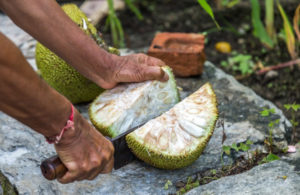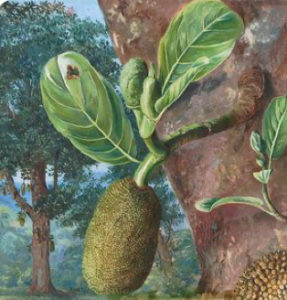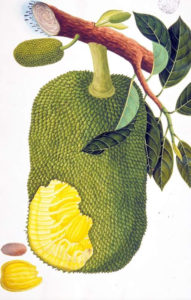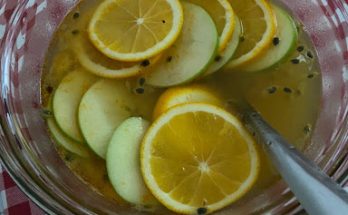

By Sharmini Jayawardena
🌳In honour of all trees, brought down and yet to be replaced by replanting🌲

From koslanda.org , The benevolent Jak

Alamy stock photo: A cross section of the jak fruit
Today, I’m dreaming of a lunch of boiled unripe Jak fruit, also known as Kos (Sinhala), which is a favourite simple meal of many Sri Lankans. It is usually eaten with freshly scrapped coconut, pol sambol, (coconut sambol), fried dry fish 🐠🎣, (karavala badung) or dry fish curry, or with other favourite Sri Lankan curries.

Thambapu kos served in a lotus leaf with pol sambol
It is an excellent substitute for rice and it is the reason why most Sri Lankans don’t go hungry!
Boiled jak, (which is often mis-spelled as Jack 😀), is what I salivate for, whenever Sri Lanka comes to mind, and I like it with what I would like to call, the three stars ⭐️, which are freshly scrapped coconut, coconut sambol and karavala badung/curry!
I stumbled upon this article below ⬇ while searching for pix of the jak fruit and I found it to be very interesting. So, I’m sharing it here.
Once, while listening in on a morning show of a radio 📻 station in Sri Lanka, the DJ asked the question, what comes to mind when you think of Sri Lanka, I promptly replied – jak! I could hear laughter coming from the studio 😁.
While growing up in Colombo, Sri Lanka, I had my fortnightly fix of thambapu kos sorted out by my grand mother’s jak tree which was known as a dhaha ata maasey kos, which translates to eighteen month jak, meaning – a jak tree that bears fruit in eighteen months from being planted.

Constance Frederica Gordon Cumming (1837-1924)
So, we had our regular supply from my grandma’s single jak tree which grew tall and strong. Mmm… the aroma of boiled jak wafting from her traditional Sinhalese kitchen was beyond belief. She had a smoked out and blacked with soot firewood hearth which some Sri Lankans took umbrage with Chef Peter Kuruvita, for exposing to the world 😀😃😄! I, on the other hand, have no problem at all talking about the rustic Sri Lankan stove, although it is no easy task cooking on one of those. You have to keep blowing and constantly rearrange the fire wood to keep the fires burning as it were! 😀

A stove in a rustic Sinhalese kitchen
To prepare a jak fruit for boiling is in itself an arduous process for some, for it has a sticky substance emanating from it, known as – kohollae. Though once, I completed this task with aplomb, if I may say so.

Cutting a jak fruit
Godwin Witane says this:
“The jak tree is called a kiri gaha as the slightest damage done to its bark would yield ample sap white in colour like milk.” It is also known as herali gaha.
To make a long story short, you have to cut through the many layers of the fruit to the core from which you extricate the edible part of the jak fruit which are the kos madulu and kos aeta or the rather rubbery pulpy segments and seeds.

Hortus Malabaricus (1678-1693)
Then, you wash the segments of rubbery pulp, remove the seeds and slice it not too finely. Put it all in a pot with a few seeds scrapped off of its brown coating and cut in half. This is believed to also add to the flavour of the dish.
Now, you add water to cover the jack, add a little salt 🧂 and boil it. Take it out of the fire before it becomes mushy.
The resultant main dish is a soft, not too mushy, light yellow carb dish. Have a belly full of jak as they say in jest, over in Sri Lanka.
The young small fruit, of the jak tree is called polos and is made into a dish known as polos maaluva. It almost mimics meat and is eaten as an accompaniment with rice and other curries.

The Young Jak Fruit, Polos. 333 Jak Fruit, Singapore. Marianne North. Royal Botanic Gardens, Kew

Polos Ready For Cooking

Polos Maaluva
Kos is also made into a creamy curry, known as kiri kos, and eaten as an accompaniment with steamed rice, which I like very much.

Jak is also made in to a mallung, where the finely diced pulp is cooked together with a paste of ground scrapped coconut, mustard seeds and other condiments.
The jak seeds are cooked as a separate dish, which is called kos aeta kalu pol maaluva. This means jak seeds cooked as a curry with the roasted and ground paste of freshly scrapped coconut.

Kos aeta kalu pol maaluva
It is also had as a confection, cut into strips, deep fried and dipped in sugar/jaggery/treacle syrup.
There is also what is known in Sinhala as atu kos, which is sun dried sliced jak, and this is a form of preserving the unripe fruit.
The jak fruit, ripened on the tree, makes for an excellent dessert as vela or varaka, (the two types of Jak trees found in Sri Lanka), and is relished by Sri Lankans. It is enjoyed in this way in most parts of South East Asia, as well, like Malaysia, Singapore, Vietnam, Indonesia and Thailand.

Ripe varaka or paeni varaka
To my knowledge, boiled unripe jak is a dish unique to Sri Lanka. However, I read that it is eaten in this way in India, Bangladesh, Indonesia, and possibly in the Pacific islands as well.
The jak tree trunk makes for a good enough timber for the construction of furniture in Sri Lanka. I believe they use the really mature and gnarled tree for this purpose, as the tree is revered and held in high esteem for its food production. Therefore it is not brought down easily.
Godwin Witane says, “The jak is a protected tree in, (Sri Lanka), and therefore an official permit is required to either fell a tree or transport timber.”
In the days of yore, the Jak wood was boiled and the robes of Buddhist monks dipped in it to turn them into the saffron robes that they wear.

Jak Fruit Tree Shop, Malang, Java. From Art UK
Goats 🐐 love to eat it’s leaves and they are fed these leaves in Sri Lanka.
Legend has it that Kos Dias, counterpart of Johnny Apple Seed, of America, is responsible for the ubiquitous and prolific presence of the tree in Sri Lanka. May My Jak Story be my tribute to this unsung hero, today. Kos Dias, Bless You!

Jackfruit from the William Farquhar Collection of Natural History Drawings. Source National Museum of Singapore Facebook page. Geraldine Soh
I ran a dehydrated fruit and vegetable operation, where I developed a dehydrated jak product. This sliced, dried and packed jak was created for export to the niche market of Sri Lankan migrant workers in the Middle East.
I need to make mention here of Leaf Blogazine’s very own tree 🌳🌲 planter, Sumiitra Sooriaarratchi, who as I’ve mentioned before, has as of now, nearly a hundred trees planted to his credit.
Almost every part of the jak tree is used for the benefit of man and animal just as a coconut tree 🌴 🥥 is.
“The sap of the jak fruit is used as a gum and some villagers stick it in knobs on a rafter or on the kitchen wall to serve in medicinal purposes”, says Godwin Witane. This is the first time I’m hearing of the guey gum being used in medicine!![]()



